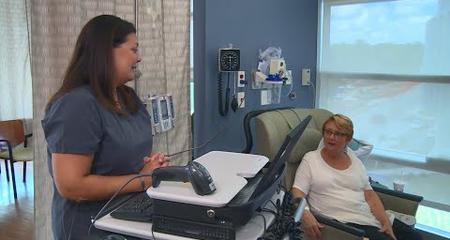 The goal of radiation therapy is to destroy any cancer cells that remain after surgery. Over the last several years, radiation technologies and delivery techniques have advanced steadily. Current tools allow radiation oncologists to customize therapies for women in a variety of situations — from early stage cancer to advanced disease.
The goal of radiation therapy is to destroy any cancer cells that remain after surgery. Over the last several years, radiation technologies and delivery techniques have advanced steadily. Current tools allow radiation oncologists to customize therapies for women in a variety of situations — from early stage cancer to advanced disease.
Radiation oncologists in the Breast Cancer Program are cancer specialists who focus exclusively on women with breast disease. They are national leaders in the development of new methods for delivering therapeutic radiation and improving patients’ quality of life.
Radiation Following Lumpectomy
Radiation therapy plays a key role in helping many women avoid mastectomy. Following a lumpectomy to remove a cancerous tumor, the patient undergoes radiation treatments intended to kill any remaining cancer cells. For appropriately selected patients, lumpectomy with radiation is as effective as mastectomy at preventing cancer recurrence.
The standard approach is to deliver external beam radiation to the entire breast (whole breast irradiation, or WBI). Patients typically receive treatments every weekday over a period of five to seven weeks.
Some patients with early stage cancer are eligible for partial breast irradiation (PBI). In this approach, radiation is concentrated on the part of the breast nearest the tumor cavity. Because healthy tissue is avoided, the radiation dose can be higher. Because the dose is higher, the treatment course is shorter. PBI can be completed within five to eight days.
Since PBI can be delivered in one week or less, it is more convenient for most women, especially those who live at a distance. Physicians in the Breast Cancer Program are national leaders in developing innovative methods of delivering PBI.
Multi-Catheter Brachytherapy
In this procedure, between 10 and 20 catheters are inserted in the breast around the tumor cavity. During a treatment session, each catheter is temporarily loaded with a small radiation source. Patients undergo multiple treatment sessions, and the catheter apparatus is worn continuously for four to five days. Physicians in the Breast Cancer Program have more than a decade of experience treating patients with multi-catheter brachytherapy.
Learn more about brachytherapy
3D Conformal External Beam Radiation
A tumor cavity can also be treated with radiation delivered from an external source. Three-dimensional (3D) conformal therapy uses radiation generated by a linear accelerator. Five to seven beams generated from different angles are focused on the site of the excised tumor. Treatment typically takes place in 10 sessions over five days.
Image-Guided IMRT, Prone Position
Physicians in the Breast Cancer Program are developing a fourth method of PBI that combines several techniques and technologies. (1) Prone position: The patient lies on her belly with her breast hanging through a hole in the treatment table. This keeps radiation out of the chest cavity, helping to avoid the delivery of radiation to the patient’s heart and lungs. (2) IMRT precision: A linear accelerator technology called intensity-modulated radiation therapy (IMRT) allows physicians to create a more tightly defined radiation field. (3) Image guidance: The linear accelerator is equipped with a low-resolution CT scanner. The scanner is used at the beginning of each treatment session to verify the position of the tumor and adjust targeting as necessary. This technique is called image-guided radiation therapy (IGRT).MammoSite
The MammoSite system involves a special catheter with a balloon tip. In an outpatient procedure, the catheter is inserted into the tumor cavity and the balloon is inflated with saline solution. During each 30-minute treatment session, a small radiation source is temporarily inserted into the balloon, delivering radiation directly to the tumor site. Treatment typically takes place in 10 sessions over five days. The Breast Cancer Program was one of six breast disease treatment programs in the nation that helped win Food and Drug Administration (FDA) approval for this technique.
Radiation Following Mastectomy
Some women who have a mastectomy still need to receive radiation therapy. These may include patients with large tumors or a cancer that has spread to the lymph nodes of the armpit.
Women with advanced breast cancer may benefit from conformal radiation therapy, which uses various technologies to produce treatment fields that “conform” tightly to specified target areas. These technologies can be used to treat the breast area, high-risk areas of the chest wall and nearby lymph nodes while minimizing the amount of radiation delivered to normal tissue.
Mammograms and the COVID-19 Vaccine – What You Should Know
Swelling of the lymph nodes is a known side effect of the COVID-19 vaccine as well as other vaccines. Although it is temporary and not harmful, these enlarged lymph nodes may be seen on your mammogram. Because swollen lymph nodes can indicate breast cancer, we may call you back for additional evaluation and possible follow-up imaging.
Virtual Visits Are Available
Safe and convenient virtual visits by video let you get the care you need via a mobile device, tablet or computer wherever you are. We’ll gather your medical records for you and get our experts’ input so we can offer treatment options without an in-person visit. To schedule a virtual visit, call 1-866-680-0505.
More to Explore





